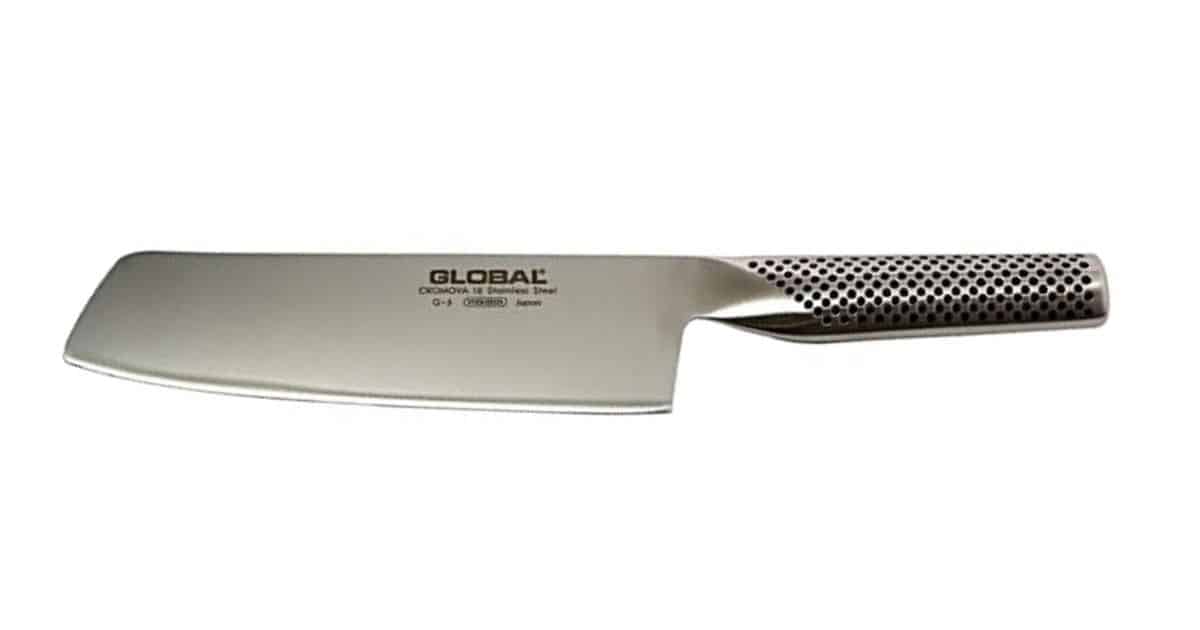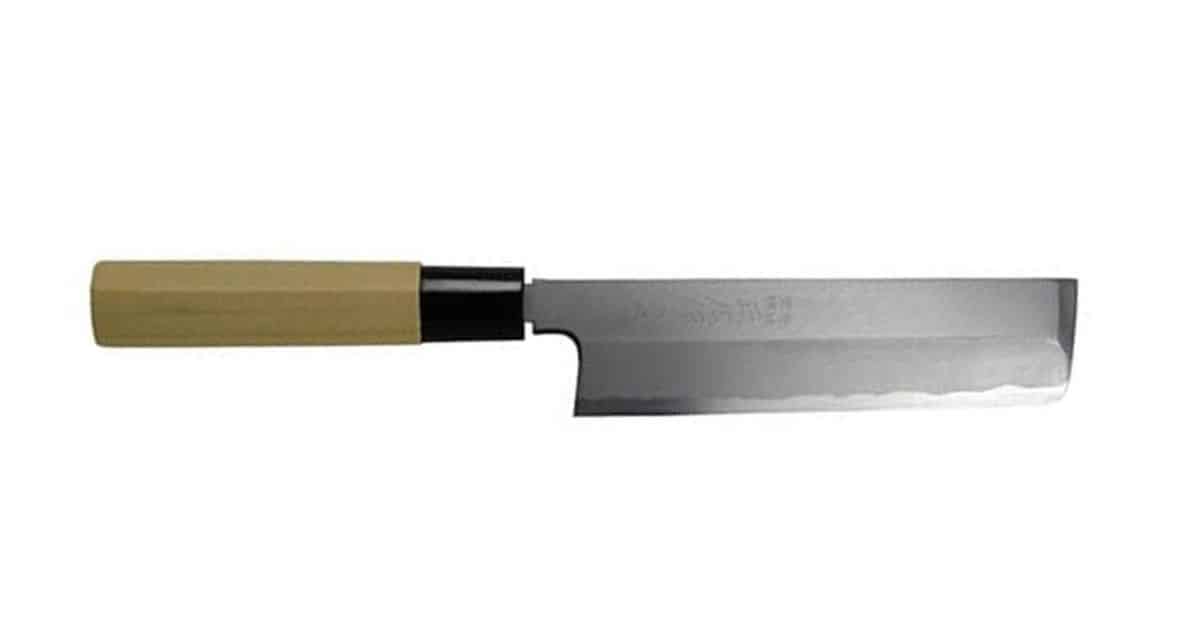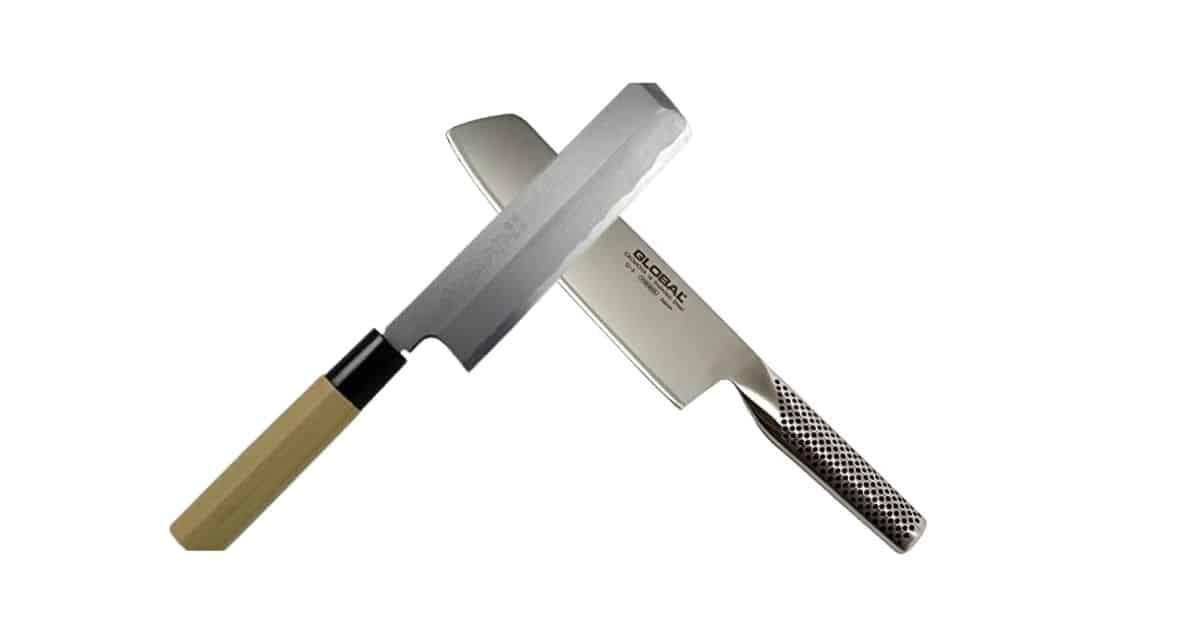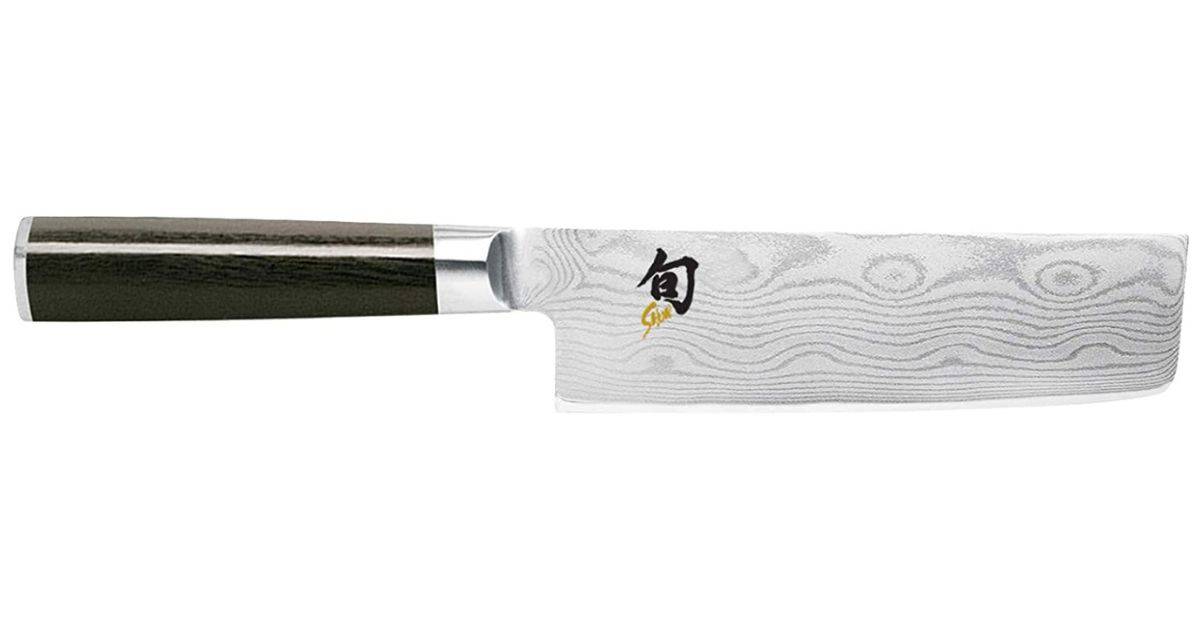Picture this: you’re prepping for your weekly meal plan in your kitchen, chopping away at a mountain of vegetables like a culinary ninja. Suddenly, you realize that your regular chef’s knife just isn’t cutting it (pun intended).
You’ve heard whispers of the traditional Japanese style knives, the Nakiri and Usuba knives, and now you can’t help but wonder if one of these might be your secret weapon for next-level veggie slicing.
Well, fear not, dear reader! I’m here to help you navigate the mysterious world of these Japanese knives with a dash of humor and a pinch of personable advice.
In this article, I’ll be answering your burning questions about Nakiri and Usuba knives, including:
What are these knives used for?
How do they compare to other popular knives, like the Santoku and Chef’s knife?
And most importantly, which one is the perfect fit for your kitchen?
So, strap on your apron and sharpen your culinary curiosity as we embark on this epicurean adventure together!
The Nakiri Knife
Now, let me tell you about my experience with the Nakiri knife. I’ve used this specialized knife in countless kitchens over my 27-year career, and let me tell you, it’s a real game-changer when it comes to vegetable prep. This double bevel knife is a champ when dealing with firm vegetables and winter squash.

What is a nakiri knife used for?
As a chef, I can tell you that a Nakiri knife is specifically designed for chopping vegetables, and dicing vegetables with precision and ease. Its thin, tall blade is perfect for making clean, straight edge even cuts, giving your veggies that professional, Insta-worthy look.
Nakiri knife vs santoku
Now, you might be wondering how the Nakiri compares to the Santoku, another popular Japanese knife. While both are great for vegetables, the Santoku is a bit more versatile, with a wider blade and curved tip that make it suitable to cut vegetables and for slicing meats and fish too. However, if it’s purely veggie action you’re after, the Nakiri might be your new best friend.
Is a nakiri knife worth it?
In my humble opinion, absolutely! If you find yourself regularly chopping a ton of vegetables, a Nakiri knife can be a real game-changer. It’s like having a sous-chef right there in your hand, making those tedious prep tasks a breeze.
Can a nakiri cut meat?
While the Nakiri is a superstar when it comes to veggies, it’s not really designed for tackling meat. That thin blade isn’t well-suited to cutting through sinew and bone. If you’re looking for a knife that can handle both veggies and meats, you might want to consider the Santoku or a good ol’ chef’s knife.
The Usuba Knife
Now, let’s dive into the world of the Usuba knife, another vegetable whisperer that has earned a spot in my kitchen over the years. I’ve found this knife to be particularly handy when I’m dealing with more delicate tasks and need a little extra precision. This is due to the single bevel knife being, in general, more delicate itself. This is the guy you go to to finish the job.

What is a usuba knife used for?
The Usuba, like its Nakiri counterpart, is another vegetable specialist within the traditional Japanese knife realm. Its name literally means “thin blade,” and that’s no joke. This knife is perfect for tasks like peeling, thinly slicing veggies, and precision cutting of vegetables. If you’re a fan of delicate garnishes or intricate veggie art, the Usuba is your go-to.
What is a usuba used for?
We’ve covered this already, but to reiterate, the Usuba is your go-to knife for precision vegetable work. The single bevel blade is incredibly sharp and ideal for thinly slicing, and creating delicate garnishes.
The shape of a usuba knife
The Usuba knife is characterized by its straight, single bevel edge thin blade and square blunt tip. This unique shape makes it perfect for those detail-oriented tasks that require a steady hand and a sharp eye.
Usuba and kamagata: differences
Now, you might come across the term “Kamagata Usuba” when researching Usuba knives. Kamagata is actually a regional variant of the Usuba, originating from the Kansai region of Japan. It features a slightly curved, pointed tip, giving it a bit more versatility compared to the classic Usuba. However, both knives are still primarily designed for precision vegetable work.
Comparing Nakiri and Usuba Knives
With our newfound knowledge of these two veggie-slaying knives, it’s time to put them head-to-head and see how they stack up against each other and some of their popular counterparts.
What is the difference between Nakiri and Usuba?
The main difference between the Nakiri and Usuba lies in their blade shapes and intended use. The Nakiri features a thin, rectangular blade that excels at chopping, slicing, and dicing vegetables. The Usuba, on the other hand, has a straight, thin blade with a flat edge squared-off tip, making it perfect for precision cutting, peeling, and creating delicate garnishes.

Is a Nakiri better than a chef knife?
This really depends on your needs and preferences. A Nakiri is fantastic for working with vegetables, but it’s not designed to handle meat. A chef’s knife is more versatile, allowing you to tackle a wider range of tasks. If you’re a veggie enthusiast, the Nakiri might be a valuable addition to your knife collection, but it probably won’t replace your trusty chef’s knife entirely.
Is a Santoku better than a Nakiri?
Again, this comes down to what you want from your knife. The Santoku is a more versatile option, suitable for vegetables, meats, and fish. However, if your primary focus is on vegetable prep, the Nakiri’s specialized design might make it a better choice for your needs.
Nakiri or Usuba: which is better?
There’s no one-size-fits-all answer to this question, as it really depends on your specific needs and preferences. If you’re looking for a knife that can handle a wide range of vegetable tasks with ease, the Nakiri is a fantastic option. If, however, you’re more interested in precision work and delicate garnishes, the Usuba might be the better choice for you.
Ultimately, the best knife for you will depend on your own cooking style and the types of tasks you most commonly perform in your kitchen.
Choosing the Right Knife for You
Now that we’ve explored the ins and outs of Nakiri and Usuba knives, it’s time to help you find the perfect match for your kitchen. Here are some factors to consider and my personal recommendations for the best knives in each category.
Factors to consider when selecting a knife
When choosing a knife, it’s essential to think about the tasks you’ll be performing most often, your personal comfort, and your budget. Ask yourself these questions:
What type of food do you mostly prepare? Are you a veggie lover or an all-around cook?
Do you need a knife for general use or something more specialized?
What’s your budget? Are you willing to invest in a high-quality knife that will last for years, or do you prefer something more affordable?
What feels comfortable in your hand? This is crucial, as a comfortable knife will make your time in the kitchen more enjoyable and efficient.

The best usuba knife: My recommendations
If you’ve decided that an Usuba knife is the right fit for your kitchen, here are my top picks: Remember – specialty knives will always be more expensive.
Yoshihiro High Carbon Blue Steel Usuba: This beauty is handcrafted in Japan and features a razor-sharp blade that’s perfect for precision work.
Masamoto KS Usuba Knife: This knife offers excellent performance at a more slightly more affordable price, making it a great option for those new to Usuba knives.

The best nakiri knife: My recommendations
For those of you leaning towards a Nakiri knife, here are knives I have owned and used in my professional career:
Shun Classic 6.5-inch Nakiri Knife: This is a top-notch Nakiri knife with a VG-MAX cutting core and layered Damascus cladding for exceptional performance and durability.
Global G-56 Classic 7 inch Nakiri This modern Japanese knife company makes great knives at affordable price points that fits both the home cook and the professional chef.
Remember, the most important thing is finding a knife that feels like an extension of your own hand and meets your specific needs in the kitchen. Happy chopping!
Key Takeaways
Before we wrap up, let’s quickly recap the essential points from this article about Nakiri and Usuba knives:
Nakiri knives are designed for chopping, slicing, and dicing vegetables with ease, while Usuba knives are perfect for precision cutting, peeling, and creating delicate garnishes.
Both Nakiri and Usuba knives are specialized for vegetable preparation, but differ in their blade shapes and intended uses.
Comparing Nakiri and Usuba knives to other popular knives, such as chef’s knives and Santokus, depends on your specific needs, preferences, and the types of tasks you perform in the kitchen.
When choosing the right knife, consider factors like your primary cooking focus, comfort, and budget.
Proper care, including hand washing, honing, and using the right cutting board, is essential to maintain the performance and longevity of your Nakiri or Usuba knife.
A Slice Above the Rest: The Final Verdict
In conclusion, both Nakiri and Usuba knives have unique strengths that make them invaluable tools for vegetable preparation. While the Nakiri knife shines in its ability to chop, slice, and dice veggies with ease, the Usuba knife excels in precision cutting, peeling, and creating intricate garnishes.
Your choice between these two knives ultimately comes down to your personal preferences, the tasks you frequently perform in your kitchen, and your comfort with the tool. By understanding the key differences between Nakiri and Usuba knives, as well as considering factors like budget and comfort, you can make an informed decision and elevate your cooking experience to new heights.
So, whether you decide to go with a Nakiri, an Usuba, or even both, remember that a sharp and comfortable knife is the key ingredient to a satisfying and efficient time in the kitchen. Happy chopping!
Frequently Asked Questions
How do I care for my Nakiri or Usuba knife?
To keep your Nakiri or Usuba knife in tip-top shape, be sure to hand wash and dry them immediately after use to prevent rust and staining. Regularly hone the blade with a honing rod to maintain its sharpness, and use a whetstone for sharpening when needed. Always store your knives in a knife block, magnetic strip, or blade guard to protect the edges and avoid accidents.
Can I use a Nakiri or Usuba knife for mincing?
Yes, you can use a Nakiri or Usuba knife for mincing, especially when it comes to vegetables. Both knives excel at cutting vegetables into small, uniform pieces, making them ideal for tasks like mincing onions, garlic, and herbs. However, for mincing meat or other tougher ingredients, a chef’s knife might be more suitable.
What type of cutting board should I use with my Nakiri or Usuba knife?
To preserve the sharpness and integrity of your Nakiri or Usuba knife, it’s best to use a cutting board made of wood or a soft, plastic material. Avoid using glass, granite, or other hard surfaces, as these can quickly dull the blade or even cause damage to the knife’s edge. A good cutting board will not only protect your knives but also make your kitchen prep work more enjoyable and efficient.



![MASAMOTO KS Japanese Usuba Knife with Sheath 7' (180mm) [HONBAZUKE] Made in JAPAN, Professional Japanese Vegetable Knife, Ultra Sharp Japanese Carbon Steel Blade, Wood Wa Handle, Black Ferrule](https://m.media-amazon.com/images/I/41XHzh1g++L._SL160_.jpg)

